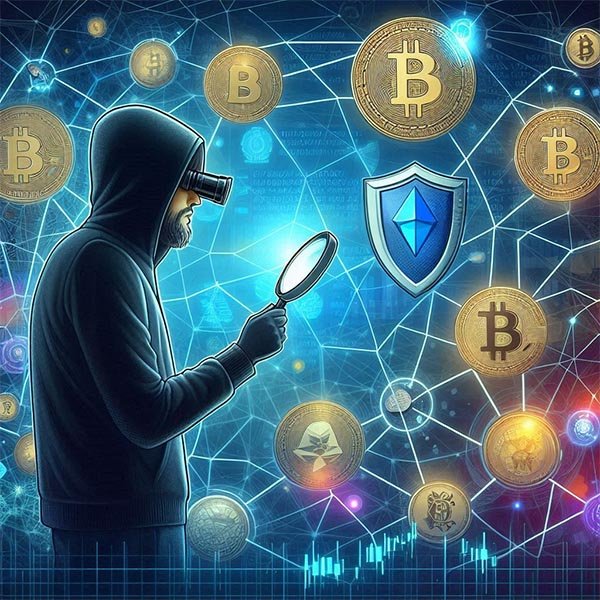Virtual currencies have become one of the most in-trend investment destinations in this high-speed-paced digital fiscal world. But to the utter dismay of investors, the growing rise of cryptocurrencies welcomed scammers who minted fake coins and scam tokens to dupe unwary investors of their hard-earned money. How to spot sham cryptocurrencies in order to save their investments? The article depicts some key steps that shall give an edge to spot sham cryptocurrencies before they create a crack in the portfolio.
What Are Fake Cryptocurrencies?
The fake cryptocurrency is a sham version of digital coins or tokens that developers create to deceive investors. Most of the scam projects claim to be the next big virtual currency, without any substantial technology or real use case to back this claim. They promise exceptionally high returns to attract people and just disappear once the funds are invested.
These come in the form of fake Initial Coin Offerings (ICOs), pump and dump, or even a completely fabricated coin. Now, as with virtual currency reaching mainstream levels, such scams have also become sophisticated; therefore, investors need to be more vigilant.
Lack of a Clear or Well-Written Whitepaper
Any decent virtual currency project is almost always accompanied by a well-written whitepaper where the technology, usage case, and vision are described. Of all the possible red flags of a fake coin, the absence of a whitepaper or a low-quality whitepaper may be counted as one of the major ones. Very often, swindlers give either general or incomplete information; they either don’t disclose technical details or describe superficially only the basic aspects of the project.



Read the whitepaper to understand whether a project is real. In that, there should be clear objectives, explanations of the technology that the project is based on, and practical usage of its token. When the whitepaper seems like a sales pitch that is an over-the-top offer, then that is a flag to stay clear of it.
No Clear Use Case for the Token
Every digital coin or token must give a use case for it to be valid; what problem does it solve? If that is not meaningfully answered by the project, then that is a scam. Every utility token that is a fraud is full of hype and no end.
Real projects tend to solve real-life existing problems, such as an improvement of blockchain technology, data security, or quicker and faster means of payments. Always do proper research about the use case before investing in virtual currency, and it must be for some reasonable and sustainable purpose.
Shady or Anonymous Development Team
Another red flag while trying to spot scam cryptocurrencies is shady or anonymous teams. A decent coin project should clearly show the people behind it, whose background can be found easily. Supposedly, the owners, founders, developers, and advisors should be open.
This really rings some alarm bells, especially if the team behind the coin is fully anonymous and cannot be found anywhere online. Scammers are well hidden to avoid accountability. Always take that one extra moment necessary to research who’s developing it, and check out their past experience in those related fields.
Unrealistic Promises and Guaranteed Returns
Indeed, the phrase “if it sounds too good to be true, it probably is” is highly valid with regard to investments, and even more when they are virtual. Most of the fake coins promise either guaranteed returns or very high profits in very short terms. The cryptocurrency market is highly volatile; nobody knows how it will fluctuate. In this segment, projects promise impossible things: multiply the investment without any possibility of risk.
A true virtual currency never is worried about taking risks in the market. The moment any project promises that it will get rich fast, perhaps it is a scam.
Pump-and-Dump Schemes
But the most running scam in the world of crypto coins goes under the name of the so-called pump-and-dump scheme. In the course of this scam, the value of one cryptocurrency is driven upwards by artificial buying, often staged via social media campaigns. When the price goes through the roof, the scammers start selling off their stake and the price subsequently crashes, thus leaving the investors with worthless coins.
To avoid becoming the next victim of a ‘pump-and-dump’, notice price jumps unrelated to any news or development, do proper market research, and seek growth based on utilitarian value.
Lack of Code Transparency
Real virtual currencies are open-source; any interested party-developers and investors alike-can review the code behind the project. Transparency like this builds trust that the technology works the way it’s described. A scam cryptocurrency won’t make code transparent to anyone, or just flat-out refuse to give any access to their code.
Before investing in any coin, check whether the project’s code is available for public scrutiny. If a project is secretive about its technology, it’s best to steer clear.



No Roadmap or Vague Future Plans
Every serious virtual currency has a well-described roadmap. The latter designates subsequent plans of the project, regarding technical improvements and partnerships, and at what times certain crucial events could occur. Any project without a clear-cut roadmap, or one whose plans sound very vague, is more than likely a scam.
Review the roadmap of the project in respect to realistic goals and achievability of the project. A very ambitious-looking roadmap, or when there is no clarity over the timeline of deliverables, raises suspicion.
Conclusion: Stay Informed to Avoid Fake Cryptocurrencies
Unfortunately, such phenomena as scam tokens or fake crypto coins really exist in the sphere of digital assets. At the same time, you cannot become a potential victim if you are watchful and study everything thoroughly. Always expect a profound and credible whitepaper, clear use case, transparency of the development team, and realistic promises from each virtual currency that may attract your interest as an investor. Knowledge and due diligence are, after all, the best protection of one’s wealth.
FAQ